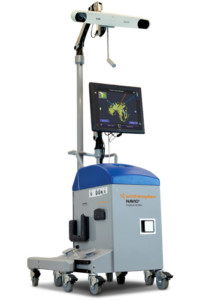![]()
Knee Replacement Questions?
Discover new, game-changing technologies that can help you start living your full life again—a more normal feeling knee,1 a smoother recovery2,3 and implants built to last
Discover more.
Fear less.
![]()

The ultimate knee replacement experience
See how knee replacement has changed—and what it can do for you.
A unique plan.
With 3D digital modeling you get a surgical plan that’s customized to your unique anatomy. That means your surgeon can perform your robotics-assisted procedure more efficiently and accurately than traditional knee replacement4,5,6
A natural fit.
With a robotics-assisted procedure using Smith+Nephew implants, you can keep more of your natural bone and ligaments, including the ACL. That means your body can maintain more of it’s natural rhythm and step.7
A unique plan.
With 3D digital modeling you get a surgical plan that’s customized to your unique anatomy. That means your surgeon can perform your robotics-assisted procedure more efficiently and accurately than traditional knee replacement4,5,6
![]()
Feed your curiosity.
Not every orthopaedic surgeon is trained to use Smith+Nephew’s technologies.

How bad is your knee pain?
Answer these common, multiple choice questions to help your doctor better understand your knee pain.
You're almost done!
Print out your results
You can print your assessment answers by clicking the "Print Results" button below. A separate window will open to display your answers. Print these out and click the Find a physician button to find a physician near you. If you do not see your results, please ensure you do not have pop-up blockers enabled for this site.

Uncover more answers
Hear from others about how getting knee surgery has restored their ability to participate in their lives.

About Andrews Institute Surgery Center
In 2007, the Andrews Institute Surgery Center was opened in Gulf Breeze, Florida. With the joined forces of Baptist Health Care and internationally renowned orthopedic surgeon James R. Andrews, the Andrews Institute Surgery Center has become a world-class institute for orthopedics and sports medicine. The Andrews Institute Ambulatory Surgery Center is a multi-specialty surgery center that works in conjunction with the Andrews Institute. With the creation of the Andrews Institute, Northwest Florida has become the underpinning for musculoskeletal treatments and research.
Bringing advancements to the market
While the Andrews Institute Surgery Center has attracted national and international attention to the area for its superior medical care in orthopedics and research, the organization has also contributed to the local economy. Since its development, the Andrews Institute has created more than 150 new jobs in the highly technical fields of musculoskeletal research and health care. At the Andrews Institute Ambulatory Surgery Center, it is our mission to provide safe, high-quality, compassionate, cost-effective, and culturally sensitive care to our patients while maintaining excellence and leadership through continuing education and technological innovation.
![Andrews Institute_night[1106]](wp-content/uploads/2021/01/Andrews-Institute_night1106.jpg)








